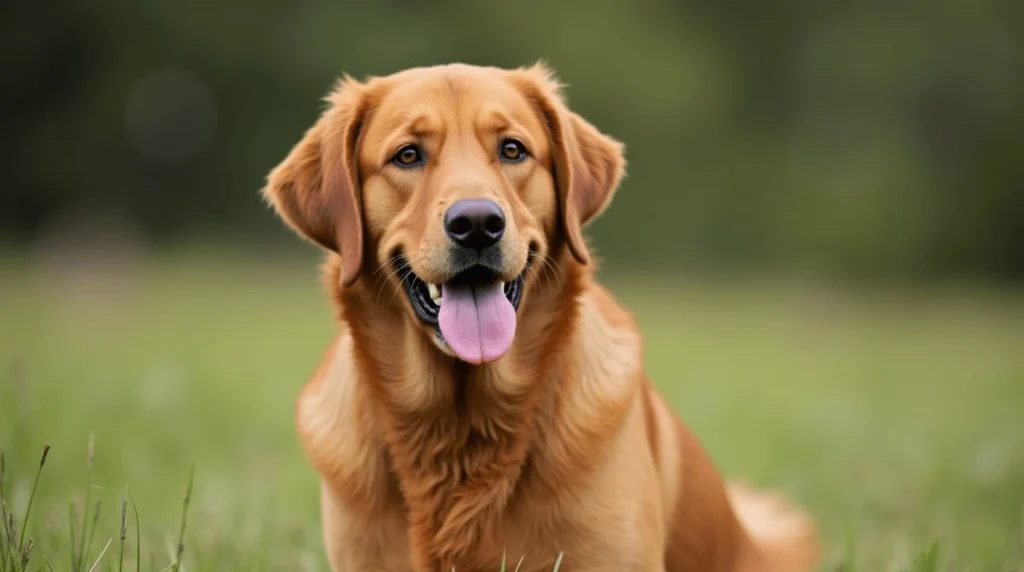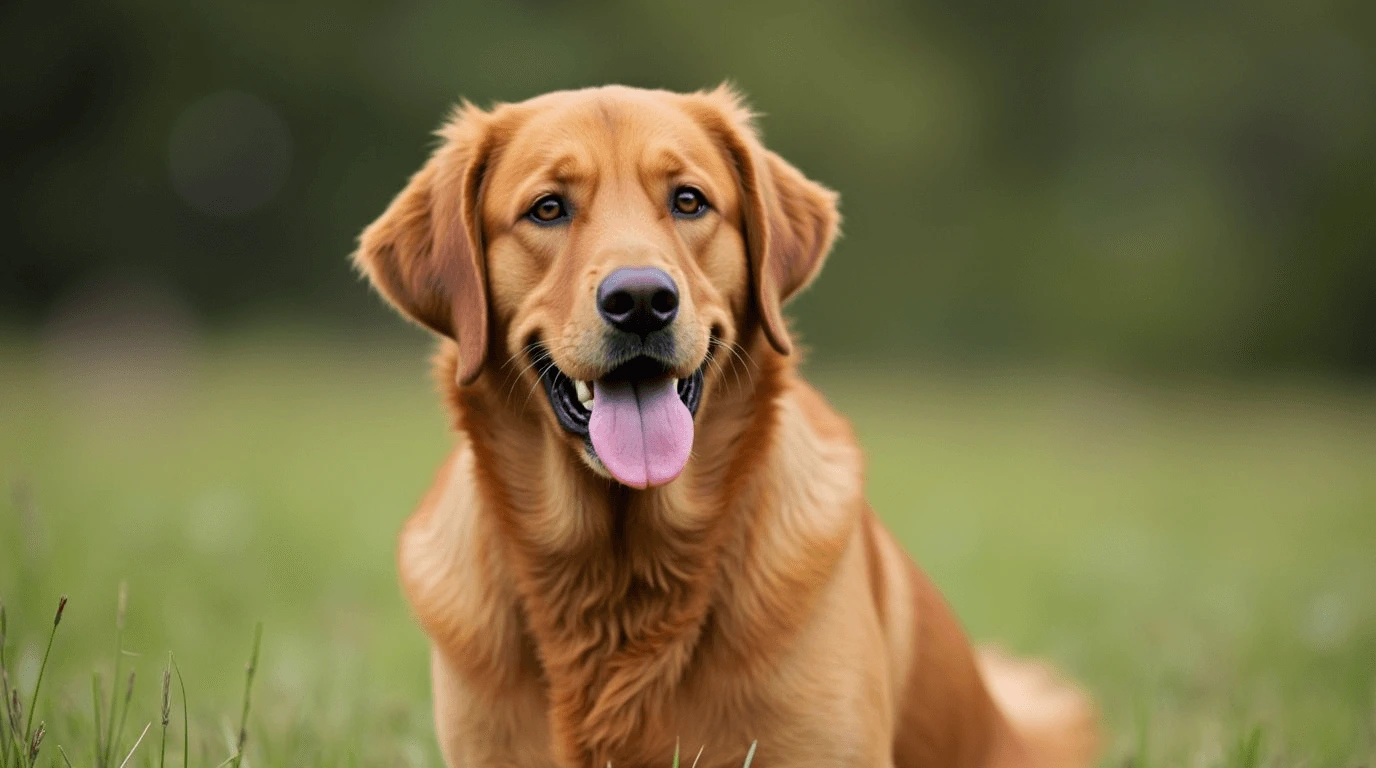My first encounter with a Red Fox Lab left me amazed. Its stunning rust-colored coat and soulful eyes told a story of generations. These Labrador Retrievers are more than just dogs—they’re a piece of history in a vibrant, reddish-brown package.
Red Fox Labs are a special color variation in the Labrador Retriever breed. They capture dog lovers’ hearts with their rich, warm fur. Unlike yellow Labs, they have a deeper, more intense color that makes them stand out.
Red Fox Labs are about 22 inches tall and weigh around 65 pounds. They show the classic Labrador strength and elegance. Their unique coat is a sign of genetic complexity and breed evolution, fascinating dog lovers for generations.
Key Takeaways
- Red Fox Labs are a color variation of Labrador Retrievers, not a separate breed
- They typically weigh around 65 pounds and stand about 22 inches tall
- Their rust-red coat is a result of specific genetic inheritance patterns
- These dogs have a typical lifespan of around 12 years
- Red Fox Labs require substantial daily exercise of 1-2 hours

Understanding the Red Fox Lab Origin
The fox red Labrador is a key part of Labrador history. These dogs have a special genetic background that links back to the 19th century. Learning about this color variation starts with its historical beginnings.
The fox red Labrador’s story is closely tied to the breed’s growth. For years, traditional colors were the norm. But the red fox color showed the breed’s genetic variety. The Kennel Club notes that yellow Labradors can have a range of colors, including fox red.
History of the Original Color
The Labrador’s history began in the 1830s with British nobles bringing St. John’s water dogs from Newfoundland. These early dogs were mostly black. Yellow and liver colors came later in the 19th century.
- The first Labrador Retrievers were imported by the Earl of Home, Earl of Malmesbury, and Duke of Buccleuch
- Formal recognition by the British Kennel Club occurred in 1903
- The American Kennel Club recognized the breed in 1917
Development of the Breed
The fox red Labrador’s story is one of preservation and appreciation. By the 1980s, this color was more accepted by breeders and fans. Events like the IGL Championship in 2001 showed the fox red Labradors’ skills.
American vs English Influence
American and English breeding lines have shaped the fox red Labrador. The American Lab type is known for its athletic build and energy. Breeders aimed to keep these dogs’ working abilities, making color less important.
“The fox red Labrador represents more than just a color – it’s a connection to the breed’s original working heritage.” – Labrador Breed Historian
Physical Characteristics and Appearance
Red Fox Labs have a coat color that ranges from light golden to deep mahogany red. They show the classic traits of Labradors but with a unique color. This makes them stand out from other Lab variations.
Looking at the red fox Lab, you’ll see several key traits:
- Height: 21.5 to 24.5 inches at the shoulder
- Weight: 55 to 80 pounds
- Body type: Muscular and athletic
- Head shape: Broad with a friendly expression
Red Fox Labs have the same physical traits as other Labradors. Their strong build shows they are both working and show line dogs. Genetic studies suggest that this rich red coloration may actually represent a more original coat color for Labradors.
“The Red Fox Lab embodies the perfect blend of classic Labrador structure and a uniquely stunning coat color.” – Canine Breed Experts
Their coat color comes from a recessive gene called the “e” gene. This gene makes the red fox shade. The color can range from light golden to deep mahogany, making each Red Fox Lab unique.
| Physical Characteristic | Red Fox Lab Specification |
|---|---|
| Coat Color | Deep red to light golden |
| Body Structure | Muscular, athletic build |
| Head Type | Broad with friendly expression |
If you’re looking for a working dog or a family pet, the Red Fox Lab is a great choice. Their impressive physical traits make them a standout among Labrador Retrievers.
The Genetics Behind Red Fox Lab Coloring
Exploring red fox Lab genetics is a journey into canine color inheritance. Their unique colors come from complex genetic rules. These rules shape their coat’s distinctive look.
Color Inheritance Patterns
The red color in Labradors comes from a special genetic mix. This mix involves the E locus gene. This gene is recessive and lets pheomelanin, the red pigment, show through.
Your Lab’s color is shaped by these gene interactions. Scientists are still learning about these interactions.
- Recessive genes control red coat expression
- Pheomelanin determines color intensity
- Genetic combinations create unique shade variations
Gene Combinations
Labrador color inheritance depends on two key genetic loci. The B locus controls black or brown, and the E locus controls yellow or red. The mix of these genes leads to a range of coat colors.
| Genotype | Possible Color |
|---|---|
| EE BB | Black |
| ee | Yellow/Fox-Red |
| Ee Bb | Potential Color Variation |
Color Variations and Intensity
Red fox Lab genetics show that not all red Labradors are the same. Their color can range from light golden to deep russet. This depends on the specific genes involved.
Breeders are studying these genetic details. They want to understand how different genes create such beautiful variations.
“The beauty of Labrador genetics lies in its complexity and the wonderful surprises it can produce.” – Canine Genetics Research Group
Temperament and Personality Traits
Red Fox Labradors have a unique temperament that makes them perfect family pets. They are very friendly and outgoing. This makes them great at forming strong bonds with their families.
Red Fox Labs are known for being sociable and adaptable. They do well in many settings and get along well with kids and other pets. Their high energy and social nature make them ideal for active families.
“A Red Fox Lab’s temperament is like a ray of sunshine – bright, warm, and always ready to make you smile.” – Canine Behavior Experts

Key Personality Characteristics
- Extremely friendly and outgoing
- Intelligent and quick to learn
- Strong desire to please their owners
- High energy levels
- Excellent with children and other pets
Because of their working line background, Red Fox Labs have a strong prey drive and athletic ability. This means they need lots of physical and mental activity to stay happy and healthy.
| Trait | Description |
|---|---|
| Social Interaction | Extremely friendly, loves human contact |
| Energy Level | High, requires regular exercise |
| Trainability | Eager to learn, responds well to positive reinforcement |
| Family Compatibility | Excellent with families, good with children |
Even though Red Fox Labs have a consistent temperament, each dog can be a bit different. Early socialization and training are key to raising a well-adjusted and confident Red Fox Lab.
Training and Intelligence
Red fox Labs are known for their high intelligence, making them easy to train. They learn quickly and work well with people. Knowing how to train them is important for a strong bond with your dog.
Early Socialization Requirements
Socializing your red fox Lab puppy is key. You should expose them to different places, people, and animals early on. This helps avoid bad behavior and boosts their confidence.
- Begin socialization between 3-16 weeks of age
- Introduce diverse sounds, textures, and experiences
- Encourage positive interactions with different people and animals
- Use treats and praise to reinforce good behavior
Training Methods and Approaches
Red fox Lab training works best with positive methods. These smart dogs do well with consistent, patient training. Short, fun sessions keep them interested and prevent boredom.
| Training Technique | Effectiveness | Recommended Duration |
|---|---|---|
| Clicker Training | High | 15-20 minutes per session |
| Reward-Based Training | Very High | 10-15 minutes per session |
| Obedience Commands | High | 5-10 minutes multiple times daily |
Working Line Characteristics
Red fox Labs from working lines are focused and strong. They are great at hunting, retrieving, and service work. They do well with clear tasks and mental challenges.
“A well-trained red fox Lab is not just a pet, but a dedicated partner ready to tackle any challenge.” – Professional Dog Trainer
Keep in mind that each dog is different in training. Be patient, consistent, and understand your dog’s personality for the best results.
Health Considerations and Lifespan
Knowing about red fox Lab health is key to a long, joyful life for your pet. Labradors usually live between 10 to 12 years. But, with the right care, they can live better and maybe even longer.
Red Fox Labs might face health issues that need careful attention:
- Hip and elbow dysplasia
- Progressive retinal atrophy (PRA)
- Exercise-induced collapse (EIC)
- Ear infections
- Genetic eye conditions
Preventive care is your best ally. Regular vet visits can spot problems early. Nutrition is vital for your Red Fox Lab’s health. Feed them high-quality dog food made for big breeds, and watch their weight.
“Prevention is always better than cure when it comes to your dog’s health.” – Veterinary Experts
Genetic tests can reveal inherited health risks. Important health checks include:
- Hip and elbow joint evaluations
- Eye examinations
- Genetic disorder screening
- Overall physical fitness assessment
Make sure your Red Fox Lab gets enough exercise and mental play. Keeping them at a healthy weight and active can greatly improve their health. This might even add years to their life.
Keep an eye out for signs like tiredness, appetite changes, or trouble moving. Catching health issues early can greatly improve treatment results and your dog’s life quality.
Exercise and Activity Requirements
Red fox Labs are full of energy and need lots of physical and mental play. It’s key to keep them healthy and happy. They need a mix of activities to stay active and engaged.
Daily Exercise Needs
Labrador activities should include at least one hour of exercise every day. A good routine for your red fox Lab should have both physical and mental challenges. Here are some exercise tips:
- Brisk walks covering about three miles
- 20-30 minutes of intense physical activity, 3-4 times weekly
- Aim for around 10,000 steps per day
Mental Stimulation Activities

Exercise for red fox Labs isn’t just about moving. They also need mental challenges to avoid boredom and bad behavior. Try these fun activities:
- Interactive puzzle toys
- Trick training sessions
- Hide-and-seek games
- Obedience training challenges
Swimming and Water Activities
Labradors love water, making swimming a great exercise. Swimming is a low-impact, full-body workout that’s perfect for your red fox Lab. Here are some water activities:
- Retrieving toys from water
- Structured swimming sessions
- Beach or lake play
“A tired Lab is a happy Lab” – Professional Dog Trainers
Remember to slowly increase exercise intensity. Always watch your dog’s energy and health during activities.
Grooming and Maintenance
Keeping your red fox Lab’s coat in top shape needs regular care. Grooming is key to your dog’s health and looks. Labradors have a thick double coat that sheds a lot, so they need constant grooming to keep fur under control and skin healthy.
Here’s what your Labrador grooming routine should include:
- Weekly brushing to remove loose hair
- Regular bathing every 4-6 weeks
- Nail trimming every 3-4 weeks
- Dental hygiene with daily brushing
- Ear cleaning to prevent infections
When your Labrador sheds more, you’ll need to groom them more often. They shed twice a year, losing a lot of hair in spring and before winter. Daily brushing is crucial during these times to handle the extra hair.
| Grooming Task | Frequency | Purpose |
|---|---|---|
| Brushing | 1-2 times weekly | Remove loose hair, distribute natural oils |
| Bathing | Every 4-6 weeks | Clean coat, reduce odor |
| Nail Trimming | Every 3-4 weeks | Prevent overgrowth, maintain foot health |
Pro tip: Use a high-quality deshedding tool like the Furminator to effectively manage your Lab’s thick coat during heavy shedding periods.
Don’t shave your red fox Lab. Their double coat keeps them warm and protects from sunburn. Stick to regular brushing and professional grooming to keep them comfortable and stylish.
Conclusion
Choosing a red fox Lab means picking a dog with a rich history and great versatility. These dogs look amazing and have a wonderful temperament. They are perfect for active families or anyone who wants a loyal friend.
Red fox Labs are more than pets; they carry a legacy of working dogs. They are smart and can fit into many roles, from hunting to service work. Their unique dark yellow coat makes them stand out, showing their genetic uniqueness.
Looking after a red fox Lab requires a lot of effort. They need lots of exercise, training, and health care. Even though they might not do well in dog shows, their skills and loyalty are more important. It’s key to know their genetic background, keep up with vet visits, and give them mental and physical challenges.
Table of Contents
Having a red fox Lab is a rewarding experience. It’s filled with love, adventure, and friendship. By choosing this breed, you’re not just getting a pet. You’re gaining a loving family member who will bring joy and energy into your life.

